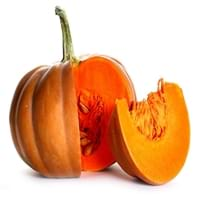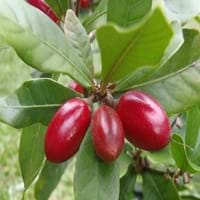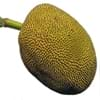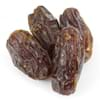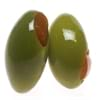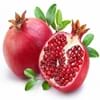Health Benefits
Arthritis treatment, Cancer prevention, High Cholesterol Regulation, Lower blood pressure, Helps Prevent cataract, Prevents gall stones, Ulcer treatment, Weight loss properties
Good for diabetics, Improves well-being, Miraculin/miracle fruit makes sour things taste sweet
General Benefits
Boosts respiratory health, Eliminate parasites and infections, Protects against birth defects, Strengthens bones
Has taste modifying effect
Skin Benefits
Heals sunburn, Hydrates skin, Skin rejuvenation
NA
Hair Benefits
Regulates hair growth
NA
Allergy Symptoms
Abdominal cramps, Anaphylaxis, Digestive Problems, Dizziness, Eczema, Fainting, Hives, Inflammation, Itching, Tingling sensation in wrist and face, Vomiting, Wheezing
Itching, Skin rash
Side Effects
Kidney and gallbladder diseases
Changes taste of food eaten after this fruit, Coagulation
Best Time to Eat
Along with meal, Don't eat after meal, Morning time (before lunch)
As a snack in the late afternoon, Eat the fresh ones, avoid mixing with any other foods, don't eat after meal., Morning time (before lunch)
Protein to Carb Ratio
Not Available
Vitamin A (Retinol)
Not Available
Vitamin B1 (Thiamin)
Not Available
Vitamin B2 (Riboflavin)
Not Available
Vitamin B3 (Niacin)
Not Available
Vitamin B5 (Pantothenic Acid)
Not Available
Vitamin B6 (Pyridoxin)
Not Available
Vitamin B9 (Folic acid)
Not Available
Vitamin C (Ascorbic Acid)
Vitamin K (Phyllochinone)
Not Available
Lutein+Zeaxanthin
Not Available
Phytosterol
Not Available
Water Content
Not Available
Calories in Fresh Fruit with Peel
Not Available
Calories in Fresh Fruit without Peel
Not Available
Calories in Frozen Form
Not Available
Not Available
Calories in Dried Form
Not Available
Not Available
Calories in Canned Form
Not Available
Calories in Juice
Not Available
Calories in Jam
Not Available
Calories in Pie
Not Available
Season
All seasons
Monsoon
Varieties
Jarrahdale, Peanut, Lakota, Cow, Sugar, Caribean, Red kuri, Buttercup and Pink lady
Gymnema Sylvestre and Thaumatococcus Daniellii
Color
Blue, Green, Orange, Red, White
Dark red
Inside Color
Creamy Yellow
Greyish-white
Taste
Creamy, Soft, Sweet
NA, Sweet
Origin
Mexico
West Africa
Soil Type
Clay loam, Sandy loam, Well-drained
Well-drained
Climatic Conditions
Warm to hot climate
Rainfall
Facts about
- The name pumpkin has its roots in the Greek word ‘pepon’, meaning ‘large melon’.
- The largest pumpkin ever grown weighed 1,140 pounds.
- Pumpkins were once known for removing freckles & curing snake bites.
- The name 'Miracle' because of the magical experience you get after eating it.
- When you have lemon after eating this fruit, it tastes sweet as if it is added with sugar.
- It is also used as natural sweetener.
Other Countries
Egypt, India, Indonesia, Iran, Italy, Mexico, Russia, Spain, United States of America
NA
Top Importer
United States of America
Not Available
Top Exporter
China
United States of America
Botanical Name
Cucurbita maxima
Synsepalum Dulcificum
Synonym
Cucurbita pepo, Squash
Miracle Berry, Miraculous Berry and Sweet Berry
Subkingdom
Tracheobionta
Tracheobionta
Division
Magnoliophyta
NA
Subclass
Dillenhidae
Asteridae
Order
Cucurbitales
Ericales
Family
Cucurbitaceae
Sapotaceae
Genus
Cucurbita
Synsepalum
Species
Cucurbita mixta
S. dulcificum
Generic Group
Not Available
Not Available
Difference Between Pumpkin and Miracle fruit
We might think that Pumpkin and Miracle fruit are similar with respect to nutritional value and health benefits. But the nutrient content of both fruits is different. Pumpkin and Miracle fruit Facts such as their taste, shape, color, and size are also distinct. The difference between Pumpkin and Miracle fruit is explained here.
The amount of calories in 100 gm of fresh Pumpkin and Miracle fruit with peel is 26.00 kcal and Not Available and the amount of calories without peel is 30.00 kcal and Not Available respectively. Thus, Pumpkin and Miracle fruit belong to and category.These fruits might or might not differ with respect to their scientific classification. The order of Pumpkin and Miracle fruit is Cucurbitales and Ericales respectively. Pumpkin belongs to Cucurbitaceae family and Miracle fruit belongs to Sapotaceae family. Pumpkin belongs to Cucurbita genus of Cucurbita mixta species and Miracle fruit belongs to Synsepalum genus of S. dulcificum species. Beings plants, both fruits belong to Plantae Kingdom.
